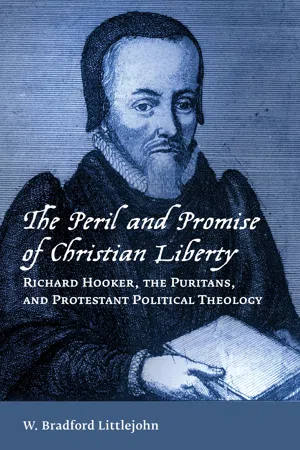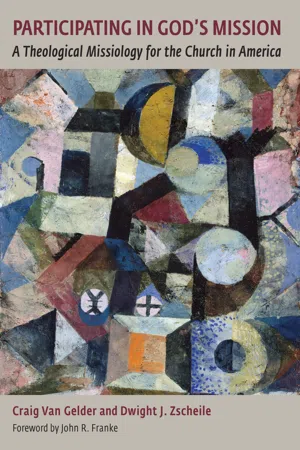History
Puritan Challenge
The Puritan Challenge refers to the religious and political movement in 17th century England that sought to reform the Church of England. Puritans aimed to purify the church of what they saw as Roman Catholic practices and beliefs. Their challenge to the established religious and political order led to significant social and political upheaval during this period.
Written by Perlego with AI-assistance
Related key terms
4 Key excerpts on "Puritan Challenge"
- eBook - ePub
- R.H. Tawney(Author)
- 2017(Publication Date)
- Routledge(Publisher)
1 A new world, it was evident, had arisen. And this new world, born of the vision of the mystic, the passion of the prophet, the sweat and agony of heroes famous and unknown, as well as of mundane ambitions and commonplace cupidities, was one in which, since “Thorough” was no more, since property was secure, and contracts inviolable, and the executive tamed, the judicious investments of business men were likely to yield a profitable return. So the epitaph, which crowns the life of what is called success, mocks the dreams in which youth hungered, not for success, but for the glorious failure of the martyr or the saint.I. PURITANISM AND SOCIETYThe principal streams which descended in England from the teaching of Calvin were three—Presbyterianism, Congregationalism, and a doctrine of the nature of God and man, which, if common to both, was more widely diffused, more pervasive and more potent than either. Of these three off-shoots from the parent stem, the first and eldest, which had made some stir under Elizabeth, and which it was hoped, with judicious watering from the Scotch, might grow into a State Church, was to produce a credal statement carved in bronze, but was to strike, at least in its original guise, but slender roots. The second, with its insistence on the right of every Church to organize itself, and on the freedom of all Churches from the interference of the State, was to leave, alike in the Old World and in the New, an imperishable legacy of civil and religious liberty. The third was Puritanism. Straitened to no single sect, and represented in the Anglican Church hardly, if at all, less fully than in those which afterwards separated from it, it determined, not only conceptions of theology and church government, but political aspirations, business relations, family life and the minutiœ of personal behavior.The growth, triumph and transformation of the Puritan spirit was the most fundamental movement of the seventeenth century. Puritanism, not the Tudor secession from Rome, was the true English Reformation, and it is from its struggle against the old order that an England which is unmistakably modern emerges. But, immense as were its accomplishments on the high stage of public affairs, its achievements in that inner world, of which politics are but the squalid scaffolding, were mightier still. Like an iceberg, which can awe the traveller by its towering majesty only because sustained by a vaster mass which escapes his eye, the revolution which Puritanism wrought in Church and State was less than that which it worked in men’s souls, and the watchwords which it thundered, amid the hum of Parliaments and the roar of battles, had been learned in the lonely nights, when Jacob wrestled with the angel of the Lord to wring a blessing before he fled. - eBook - ePub
The Reign of Elizabeth I
1558–1603
- Stephen J. Lee(Author)
- 2020(Publication Date)
- Routledge(Publisher)
PURITANISM AND THE PURITAN ‘THREAT’BACKGROUNDThe term ‘Puritan’ was initially one of abuse and was not widely used during the sixteenth century. It was first applied to those who resisted the official doctrine and rubric in the 1559 Prayer Book. Those who came under the generic term preferred at the time to call themselves ‘the Godly’ or ‘True Gospellers’. Analysis 1 considers the question of definition and how the views of historians have changed over the past century. Whether or not Puritanism was a ‘threat’ to the religious and political establishment is dealt with in Analysis 2; while the historiography of this issue is the subject of Analysis 3.ANALYSIS 1: WHO WERE THE ‘PURITANS’?This has certainly been a slippery term to define. P. Williams maintained that there was no rigid body of doctrine that could be called ‘Puritanism’ – but that there were ‘Puritans’.1 The main characteristics included the influence of Calvin’s ideas, especially of predestination, a desire to practise the precepts of Geneva’s ‘godly society’ and an ordering of their moral behaviour strictly in accordance with the Bible. They were strongly anti-Catholic and emphasised the need for further Protestant reform of the Church of England; in particular, they wanted a simplification of clerical dress and they opposed ‘popish’ and ‘superstitious’ rituals such as making the sign of the cross and kneeling at communion. Their services also became renowned for the central role of preaching.The main areas inhabited by Puritans were the south-west, especially Devon and Cornwall; the south-east, including Essex and Kent; East Anglia and Lincolnshire; parts of the Midlands; and southern Lancashire, especially Manchester – where they were seen as a counter-balance to the preponderance of Catholics elsewhere in the north-west. Some historians have argued that Puritans came primarily from the middle classes, especially from the more enterprising groups of skilled workers, shopkeepers and merchants. This appears to be borne out by the distribution of Puritanism, which was most widespread in towns, ports and other areas of more concentrated economic activity. But the explanations attributed to this need to be dealt with cautiously. On the one hand, it is possible to make a direct connection between religious affiliation and occupation on geographical lines: radical influences, for example, entered England from the continent along trade routes. It is also reasonable to argue that skilled occupational groups would be more likely to have sufficient education to be attracted by the need for self-thought and responsibility which Puritanism tended to promote. On the other hand, some arguments have gone too far. R.H. Tawney observed in 1926 that there was a close affinity between Puritanism and the rise of capitalism – ‘Puritanism became a potent force in preparing the way for the commercial civilization’ – and that opposition to restraints imposed by church and state on ‘individual self-interest’ appeared ‘quite early in the reign of Elizabeth’, eventually going on to influence the powerful movement which ‘finally triumphed at the Revolution’.2 - eBook - ePub
The Peril and Promise of Christian Liberty
Richard Hooker, the Puritans, and Protestant Political Theology
- W. Bradford Littlejohn(Author)
- 2017(Publication Date)
- Eerdmans(Publisher)
CHAPTER THREE “Exact Precise Severity” The Puritan Challenge to Prince and Conscience The greatest liberty and freedom of Christians is to serve the Lord according to his revealed will, and in all things to hang upon his mouth.Thomas Cartwright, “Second Replie to Whitgift”1I. The Beginnings of a New MovementBetween 1567 and 1572, the Elizabethan Church entered upon a decisive new stage, engendering a movement that was to leave a wide and lasting legacy on the Reformed world over succeeding centuries, particularly in Britain and America, a movement traditionally known as “Puritanism.” Although a number of scholars have quite helpfully traced lines of development for the Puritan movement back to the Marian exile, or the Edwardian reform, or even the Henrician period (lines we have to some extent followed in the previous chapter),2 there is wisdom in the preference among contemporary scholars to confine the term to the Elizabethan era and beyond. Indeed, even the Elizabethan Vestiarian Controversy, despite its central importance to the development of the new movement, represents more of a prologue to “Puritanism” than its first chapter. A great deal seems to have changed between the conclusion of this controversy in 1567 and the outbreak of the Admonition Controversy in 1572, when young radicals John Field and Thomas Wilcox, frustrated by the lack of official response to reforming overtures and complaints, published and disseminated a scandalously rancorous Admonition to Parliament.The document, clearly intended (despite its name) as a piece of public propaganda,3 ignited a firestorm of controversy: Field and Wilcox were imprisoned, an official Answere by John Whitgift was commissioned, and battle lines were drawn as pamphlets and counter-pamphlets, treatises and counter-treatises, began to multiply. The immediate literary controversy, in which Whitgift emerged as the spokesman for the establishment, and Thomas Cartwright as the spokesman for the Puritans, lasted until 1577, but the movement that the Admonition called into being lasted in organized form until the early 1590s, when it had grown so militant that the bishops and Privy Council took dramatic steps to quash it. The cast of this new act in the drama, however, were quite different from those who had fought it out with the bishops over vestments in 1565–67, most of whom had grudgingly submitted when it was clear the policy was inflexible. Of the twenty scrupulous Protestants who presented a supplication to the bishops over vestments in 1565, only three, says Patrick Collinson, “remained staunch to the radical cause until their deaths,” and most “at once dissociated themselves from the new extremism.” So much so, in fact, that from 1572 on, “we are evidently witnessing the beginnings of a new movement rather than the conversion of the old.”4 - eBook - ePub
Participating in God's Mission
A Theological Missiology for the Church in America
- Craig Van Gelder, Dwight Zscheile(Authors)
- 2018(Publication Date)
- Eerdmans(Publisher)
41The biblical narrative of the Exodus played large in this vision as the Puritans immigrated to the Promised Land. Finally, they were free to form a society where church and state worked together to re-create humanity—what they conceived of as divine destiny. This perspective represents a rather high view of God’s unique blessing, leading the Puritans to legislate strong communal norms of moral sanctification in order to usher in the millennial kingdom. It is also a strain of Christianity that introduced into denominational church life in America the concept of “Christian” as an adjective to define America, a strain that is still very much alive and contested to this day.Their vision of community was eschatological in character: they believed that establishing a society without sin would bring a new era for all of humankind.42 Central to this approach was discipline: bringing all of life under what they understood to be biblical norms of behavior and control. It was a social imaginary that gave birth to one version of what became known as American exceptionalism: (1) that America’s history and setting was unique in its being formed as a new nation; (2) that the political ideology of personal liberty and responsibility are central to its core identity; and (3) that America possesses unique traits and has a mission to serve as an example for the broader world to follow.43Another version of American exceptionalism drew more from Enlightenment ideals that held to a deistic view of God. Founding fathers such as Thomas Jefferson championed the exercise of human reason in constructing a social contract to form a better society relative to the unique situation of the colonies. They held to a sense of civic responsibility that increased in importance during the mid-1700s, as tensions with England began to grow and calls for independence began to increase. The call for patriotic loyalty in the support of the revolutionary cause came to be nurtured by many within these churches, as it was among churches that developed from sectarian roots.44
Learn about this page
Index pages curate the most relevant extracts from our library of academic textbooks. They’ve been created using an in-house natural language model (NLM), each adding context and meaning to key research topics.


